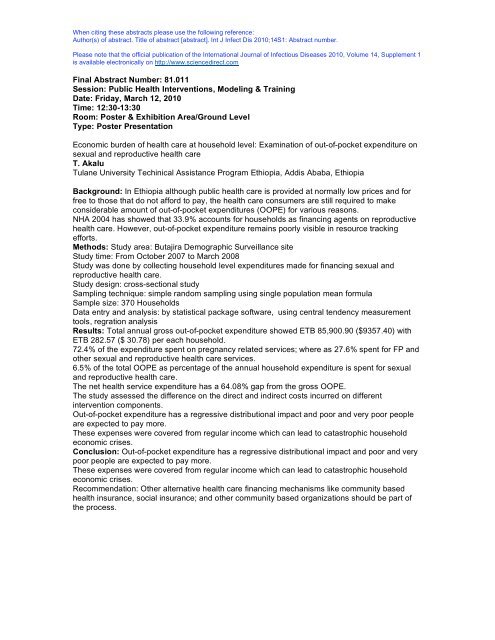14th ICID - Poster Abstracts - International Society for Infectious ...
14th ICID - Poster Abstracts - International Society for Infectious ...
14th ICID - Poster Abstracts - International Society for Infectious ...
Create successful ePaper yourself
Turn your PDF publications into a flip-book with our unique Google optimized e-Paper software.
When citing these abstracts please use the following reference:<br />
Author(s) of abstract. Title of abstract [abstract]. Int J Infect Dis 2010;14S1: Abstract number.<br />
Please note that the official publication of the <strong>International</strong> Journal of <strong>Infectious</strong> Diseases 2010, Volume 14, Supplement 1<br />
is available electronically on http://www.sciencedirect.com<br />
Final Abstract Number: 81.011<br />
Session: Public Health Interventions, Modeling & Training<br />
Date: Friday, March 12, 2010<br />
Time: 12:30-13:30<br />
Room: <strong>Poster</strong> & Exhibition Area/Ground Level<br />
Type: <strong>Poster</strong> Presentation<br />
Economic burden of health care at household level: Examination of out-of-pocket expenditure on<br />
sexual and reproductive health care<br />
T. Akalu<br />
Tulane University Techinical Assistance Program Ethiopia, Addis Ababa, Ethiopia<br />
Background: In Ethiopia although public health care is provided at normally low prices and <strong>for</strong><br />
free to those that do not af<strong>for</strong>d to pay, the health care consumers are still required to make<br />
considerable amount of out-of-pocket expenditures (OOPE) <strong>for</strong> various reasons.<br />
NHA 2004 has showed that 33.9% accounts <strong>for</strong> households as financing agents on reproductive<br />
health care. However, out-of-pocket expenditure remains poorly visible in resource tracking<br />
ef<strong>for</strong>ts.<br />
Methods: Study area: Butajira Demographic Surveillance site<br />
Study time: From October 2007 to March 2008<br />
Study was done by collecting household level expenditures made <strong>for</strong> financing sexual and<br />
reproductive health care.<br />
Study design: cross-sectional study<br />
Sampling technique: simple random sampling using single population mean <strong>for</strong>mula<br />
Sample size: 370 Households<br />
Data entry and analysis: by statistical package software, using central tendency measurement<br />
tools, regration analysis<br />
Results: Total annual gross out-of-pocket expenditure showed ETB 85,900.90 ($9357.40) with<br />
ETB 282.57 ($ 30.78) per each household.<br />
72.4% of the expenditure spent on pregnancy related services; where as 27.6% spent <strong>for</strong> FP and<br />
other sexual and reproductive health care services.<br />
6.5% of the total OOPE as percentage of the annual household expenditure is spent <strong>for</strong> sexual<br />
and reproductive health care.<br />
The net health service expenditure has a 64.08% gap from the gross OOPE.<br />
The study assessed the difference on the direct and indirect costs incurred on different<br />
intervention components.<br />
Out-of-pocket expenditure has a regressive distributional impact and poor and very poor people<br />
are expected to pay more.<br />
These expenses were covered from regular income which can lead to catastrophic household<br />
economic crises.<br />
Conclusion: Out-of-pocket expenditure has a regressive distributional impact and poor and very<br />
poor people are expected to pay more.<br />
These expenses were covered from regular income which can lead to catastrophic household<br />
economic crises.<br />
Recommendation: Other alternative health care financing mechanisms like community based<br />
health insurance, social insurance; and other community based organizations should be part of<br />
the process.
















